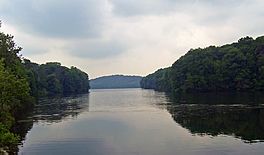Cross River Reservoir facts for kids
Quick facts for kids Cross River Reservoir |
|
|---|---|

East end of the reservoir
|
|
| Location | Westchester County, New York |
| Coordinates | 41°15′15″N 73°37′58″W / 41.2543°N 73.6329°W |
| Type | reservoir |
| Primary inflows | Cross River |
| Primary outflows | Cross River |
| Catchment area | 30 sq mi (78 km2) |
| Basin countries | United States |
| Max. length | 3.2 mi (5.1 km) |
| Surface area | 915 acres (370 ha) |
| Average depth | 36 ft (11 m) |
| Max. depth | 120 ft (37 m) |
| Shore length1 | 12.4 mi (20.0 km) |
| Surface elevation | 331 ft (101 m) |
| 1 Shore length is not a well-defined measure. | |
The Cross River Reservoir is a large lake built by people. It holds water for New York City. You can find it in Westchester County, New York, near a town called Katonah. This reservoir is part of a bigger system called the Croton Watershed. It helps supply drinking water to millions of people in New York City. Engineers built it around the year 1900. They did this by blocking the flow of the Cross River. This river is a small stream that flows into the Croton River, which then goes into the Hudson River.
The Cross River Reservoir started working in 1908. It is one of 16 water bodies in the Croton Watershed. This watershed is the closest one to New York City. The reservoir is about 3.2 miles (5.1 km) long. It gathers water from an area of 30 square miles (78 km²). At full capacity, it can hold 10.3 billion US gallons (39 million m³) of water. This makes it one of the city's smaller reservoirs.
How Water Travels to the City
The water from Cross River Reservoir takes an interesting journey. First, it flows into the Muscoot Reservoir. From there, it moves into the New Croton Reservoir. This is where the water enters the New Croton Aqueduct. An aqueduct is like a giant underground pipe or channel.
The Aqueduct's Path
The New Croton Aqueduct carries the water to The Bronx. It then reaches the Jerome Park Reservoir. In Manhattan, the water connects with the Catskill Aqueduct. This larger aqueduct brings water from even farther away. Finally, the water travels through Brooklyn and ends near the tip of Staten Island. This long journey ensures clean water reaches many homes.
Why Reservoirs Are Important
Reservoirs like Cross River are very important. They store large amounts of fresh water. This water is then treated and sent to homes and businesses. New York City relies on these reservoirs for its daily water needs. They help make sure there is enough water, even during dry times.



